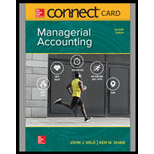
Concept explainers
1.
The variable
1.
Explanation of Solution
Given,
The actual hours are 265,000.
The variable overhead costs are $2,200,000.
The standard direct labor hours at 80% capacity is 240,000.
The variable overhead costs at 80% capacity are $1,920,000.
Compute variable overhead spending variance.
The formula to calculate the variable overhead spending variance is,
Substitute 265,000 for actual hours, $8.30 for actual variable rate and $8 for standard variable rate (refer working note).
The variable overhead spending variance is $79,500 (unfavorable).
Calculation of variable overhead efficiency variance:
The formula to calculate the variable overhead efficiency variance is,
Substitute 265,000 for the actual hours, 240,000 for standard hours and $8 for the standard variable rate.
The variable overhead efficiency variance is $200,000 (unfavorable).
Working note:
Calculation of the actual variable rate,
The actual variable rate is $8.30.
Calculation of the standard variable rate,
The standard variable rate is $8.00.
Hence, the variable overhead spending variance and variable overhead efficiency variance is $79,500 (unfavorable), and $200,000 (favorable).
2.
The fixed overhead spending and volume variances.
2.
Explanation of Solution
Given,
The actual overhead is $2,350,000.
The budgeted overhead is $2,400,000.
The standard direct labor hours at 80% capacity is 240,000.
The actual hours are 265,000 hours.
Compute the fixed overhead spending variance.
The formula to calculate the fixed overhead spending variance is,
Substitute $2,350,000 for actual overhead and $2,400,000 for budgeted overhead.
The fixed overhead spending variance is $50,000 (favorable).
Compute fixed overhead volume variance.
The formula to calculate the fixed overhead volume variance is,
Substitute $2,400,000 for the budgeted overhead and $2,650,000 for the applied overhead (refer working note).
The fixed overhead volume variance is $250,000 (favorable).
Working note:
Calculation of the applied overhead,
The applied overhead is $2,650,000.
Hence, the fixed overhead spending variance and fixed overhead volume variance is $50,000 (favorable) and $250,000 (favorable).
3.
The total overhead controllable variance.
3.
Explanation of Solution
Given,
The variable overhead spending variance is $79,500 (unfavorable).
The variable overhead efficiency variance is $200,000 (unfavorable).
The fixed overhead spending variance is $50,000 (favorable).
Compute the overhead controllable variance.
The formula to calculate the overhead controllable variance is,
Substitute $79,500 for variable overhead spending variance, $200,000 for variable overhead efficiency variance and $50,000 for fixed overhead spending variance.
The overhead controllable variance is $229,500 (unfavorable).
Thus, the total overhead controllable variance is $229,500 (unfavorable).
Want to see more full solutions like this?
Chapter 8 Solutions
Managerial Accounting - Connect Access
- Quick Logistics, Inc. had net cash from operating activities of $180,000. It paid $150,000 to purchase new delivery vehicles by signing a $120,000 note and paying the balance. Net cash from (or used for) investing activities for the period was _. a. $30,000 b. ($30,000) c. $150,000 d. ($150,000)arrow_forwardPlease explain the solution to this general accounting problem using the correct accounting principles.arrow_forwardSolve with explanation and accounting questionarrow_forward
- Please provide the correct answer to this general accounting problem using valid calculations.arrow_forwardHonda Corporation had beginning raw materials inventory of $34,500. During the period, the company purchased $128,000 of raw materials on account. If the ending balance in raw materials was $22,700, the amount of raw materials transferred to work in process inventory is?arrow_forwardFinancial accountingarrow_forward
- At the beginning of the recent period there were 1,250 units of product in a department, one-half completed. These units were finished and an additional 4,850 units were started and completed during the period. 1,100 units were still in process at the end of the period, one-third completed. Using the weighted-average valuation method the equivalent units produced by the department were ____Units. (Round your answer to nearest unit)arrow_forwardI am looking for the correct answer to this general accounting problem using valid accounting standards.arrow_forwardI am looking for the correct answer to this general accounting question with appropriate explanations.arrow_forward

 AccountingAccountingISBN:9781337272094Author:WARREN, Carl S., Reeve, James M., Duchac, Jonathan E.Publisher:Cengage Learning,
AccountingAccountingISBN:9781337272094Author:WARREN, Carl S., Reeve, James M., Duchac, Jonathan E.Publisher:Cengage Learning, Accounting Information SystemsAccountingISBN:9781337619202Author:Hall, James A.Publisher:Cengage Learning,
Accounting Information SystemsAccountingISBN:9781337619202Author:Hall, James A.Publisher:Cengage Learning, Horngren's Cost Accounting: A Managerial Emphasis...AccountingISBN:9780134475585Author:Srikant M. Datar, Madhav V. RajanPublisher:PEARSON
Horngren's Cost Accounting: A Managerial Emphasis...AccountingISBN:9780134475585Author:Srikant M. Datar, Madhav V. RajanPublisher:PEARSON Intermediate AccountingAccountingISBN:9781259722660Author:J. David Spiceland, Mark W. Nelson, Wayne M ThomasPublisher:McGraw-Hill Education
Intermediate AccountingAccountingISBN:9781259722660Author:J. David Spiceland, Mark W. Nelson, Wayne M ThomasPublisher:McGraw-Hill Education Financial and Managerial AccountingAccountingISBN:9781259726705Author:John J Wild, Ken W. Shaw, Barbara Chiappetta Fundamental Accounting PrinciplesPublisher:McGraw-Hill Education
Financial and Managerial AccountingAccountingISBN:9781259726705Author:John J Wild, Ken W. Shaw, Barbara Chiappetta Fundamental Accounting PrinciplesPublisher:McGraw-Hill Education





